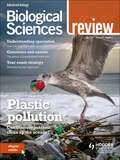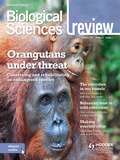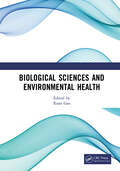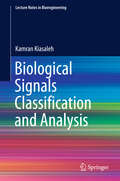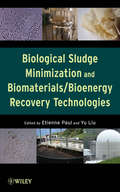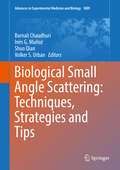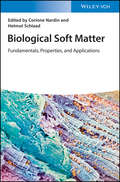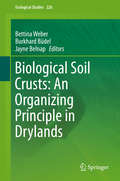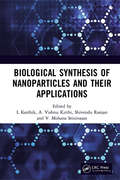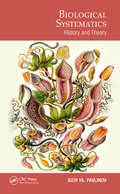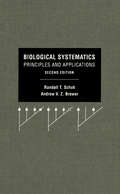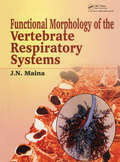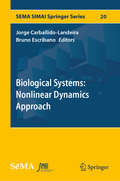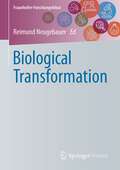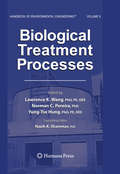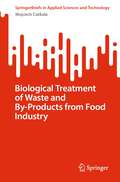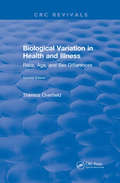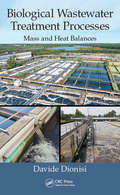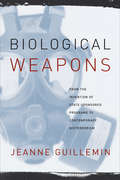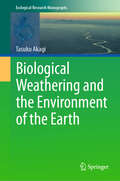- Table View
- List View
Biological Sciences Review Magazine Volume 31, 2018/19 Issue 4
by Philip Allan MagazinesThis A-level magazine makes cutting-edge biology research accessible and relevant for students, supporting them to get their best grade. Featuring the latest thinking on advanced topics, Biological Sciences Review aims to challenge students and increase their confidence with data, technical terms, practical experiments and exam skills.ContentsMarine bacteria and the plastisphereRobyn WrightBioethicsTackling cancer: getting personalChris WilmottSnake venomMax Drakeley, Liz Sheffield and Catherine McCrohanThe measure of a monkey: speciation and hybridsDuncan WrightProspectsFeeding the futureJoseph MoughanWhat is...?Sympatric speciationRobert Spooner and Raksha GohelProtecting the pinosaurLiz SheffieldLampreysCatherine McCrohanWhat is...?A ring speciesRobert Spooner and Raksha GohelStillbirthStacey Lee and Megan SharpsOutside the boxMaking sense of bird bristlesWater: transport and regulation in the bodyKevin MoffatUpgradeExams? You need a strategyMartin Rowland
Biological Sciences Review Magazine Volume 32, 2019/20 Issue 1
by Hodder Education MagazinesContents:The microbes thriving in our bowelsHidaya AlioucheSpotlightSaving the red apeKatie FrimstonBioethicsGenome editing: promises and problemsJohn BryantFighting fluSaira Hussain'Controlled variable' and 'control group'Martin RowlandCultivating clonesLiz SheffieldInterfaceModelling wildlife corridors: a tool for creating habitat in fragmented landscapesLydia ColeUpgradeWill examiners penalise my poor English?Martin RowlandUncoupling mitochondria turns up the heatKatrine WallisEvaluating experimentsThe Miller-Urey experimentAdam HartThe placentaKirsty McIntyreImages of biologyEvolution in your gardenKevin O'Dell
Biological Sciences Review Magazine Volume 32, 2019/20 Issue 2
by Hodder Education MagazinesAllergy explosion: why our immune systems react to harmless substancesCiara GartshoreBioethicsPractical ethics and prenatal screeningRebecca BennettUpgradeSuccess with successionMartin RowlandSpeciation and the tube mosquitoRobert SpoonerCollagen and scurvy: understanding the connectionEliana LingardBird adaptations for runningKevin MoffatTau protein: microtubule supporter or dementia driver?James QuinnOutside the boxThe future of food? Growing plants without soilJens ThomasSpotlightCoelacanth: how a lucky catch rewrote biologyAdam HartOur immune system: how it is controlled by stem cellsRachel OldershawProspectsWinning friends, influencing politicians: how can biologists influence those inpower?Rachel Lambert-ForsythImages of biologyMicrogreens on Mars?Liz Sheffield
Biological Sciences and Environmental Health: International Conference on Frontiers of Biological Sciences and Environmental Health (FBSEH 2023), November 3-5, 2023, Singapore
by Xuan GaoThe book captures the essence of the First International Conference on Frontiers of Biological Sciences and Environmental Health (FBSEH 2023). It provides a comprehensive roadmap to achieving sovereignty, security and safety of human health by adopting a multi-disciplinary approach to disease diagnosis, mitigation and prevention.These proceedings contains a repository of unique ideas, cutting edge research methodologies and exhaustive studies by experts, scholars from all over the world. It touches upon a wide array of topics including advances in bioengineering and genetic technologies, nutrition and disease prevention, emerging therapeutic strategies and drug delivery, along with the advent of microfluidics, wearables, and medical devices. It highlights innovative research contributions and practical applications that would prove critical in fighting cancer and genetic disorders in the future. This is a highly beneficial guide to university professors, research scholars and medical professionals in the rapidly evolving fields such as microbiology, biotechnology, biomedical engineering, molecular medicine, public health and community medicine, and healthcare sciences.
Biological Sciences in the Laboratory
by Ronald MollickWelcome to the Biology laboratory! This laboratory course is designed to meet one of the requirements of the Liberal Learning Core Curriculum. One of the Liberal Learning Areas of Inquiry is "Investigating the Natural World." This Area of Inquiry requires students to successfully complete two lecture classes and one laboratory class. The laboratory class must be related to one of the lecture classes taken. To use Biology 109L to help complete this requirement you must be currently enrolled in or have already completed one of the following: Biology 107, 108, 111, 112, 113, 114 or 115.
Biological Sequence Analysis Using the SeqAn C++ Library (Chapman & Hall/CRC Computational Biology Series)
by Andreas Gogol-Döring Knut ReinertAn Easy-to-Use Research Tool for Algorithm Testing and DevelopmentBefore the SeqAn project, there was clearly a lack of available implementations in sequence analysis, even for standard tasks. Implementations of needed algorithmic components were either unavailable or hard to access in third-party monolithic software products. Addressing these conc
Biological Signals Classification and Analysis (Lecture Notes in Bioengineering)
by Kamran KiasalehThis authored monograph presents key aspects of signal processing analysis in the biomedical arena. Unlike wireless communication systems, biological entities produce signals with underlying nonlinear, chaotic nature that elude classification using the standard signal processing techniques, which have been developed over the past several decades for dealing primarily with standard communication systems. This book separates what is random from that which appears to be random and yet is truly deterministic with random appearance. At its core, this work gives the reader a perspective on biomedical signals and the means to classify and process such signals. In particular, a review of random processes along with means to assess the behavior of random signals is also provided. The book also includes a general discussion of biological signals in order to demonstrate the inefficacy of the well-known techniques to correctly extract meaningful information from such signals. Finally, a thorough discussion of recently proposed signal processing tools and methods for addressing biological signals is included. The target audience primarily comprises researchers and expert practitioners but the book may also be beneficial for graduate students.
Biological Sludge Minimization and Biomaterials/Bioenergy Recovery Technologies
by Etienne Paul Yu LiuA comprehensive guide to sludge management, reuse, and disposal When wastewater is treated, reducing organic material to carbon dioxide, water, and bacterial cells-the cells are disposed of, producing a semisolid and nutrient-rich byproduct called sludge. The expansion in global population and industrial activity has turned the production of excess sludge into an international environmental challenge, with the ultimate disposal of excess sludge now one of the most expensive problems faced by wastewater facilities. Written by two leading environmental engineers, Biological Sludge Minimization and Biomaterials/Bioenergy Recovery Technologies offers a comprehensive look at cutting-edge techniques for reducing sludge production, converting sludge into a value-added material, recovering useful resources from sludge, and sludge incineration. Reflecting the impact of new stringent environmental legislation, this book offers a frank appraisal of how sludge can be realistically managed, covering key concerns and the latest tools: Fundamentals of biological processes for wastewater treatment, wastewater microbiology, and microbial metabolism, essential to understanding how sludge is produced Prediction of primary sludge and waste-activated sludge production, among the chief design and operational challenges of a wastewater treatment plant Technologies for sludge reduction, with a focus on reducing microbial growth yield as well as enhancing sludge disintegration The use of anerobic digestion of sewage sludge for biogas recovery, in terms of process fundamentals, design, and operation The use of the microbial fuel cell (MFC) system for the sustainable treatment of organic wastes and electrical energy recovery
Biological Small Angle Scattering: Techniques, Strategies and Tips (Advances in Experimental Medicine and Biology #1009)
by Barnali Chaudhuri Inés G. Muñoz Shuo Qian Volker S. UrbanThis book provides a clear, comprehensible and up-to-date description of how Small Angle Scattering (SAS) can help structural biology researchers. SAS is an efficient technique that offers structural information on how biological macromolecules behave in solution. SAS provides distinct and complementary data for integrative structural biology approaches in combination with other widely used probes, such as X-ray crystallography, Nuclear magnetic resonance, Mass spectrometry and Cryo-electron Microscopy. The development of brilliant synchrotron small-angle X-ray scattering (SAXS) beam lines has increased the number of researchers interested in solution scattering. SAS is especially useful for studying conformational changes in proteins, highly flexible proteins, and intrinsically disordered proteins. Small-angle neutron scattering (SANS) with neutron contrast variation is ideally suited for studying multi-component assemblies as well as membrane proteins that are stabilized in surfactant micelles or vesicles. SAS is also used for studying dynamic processes of protein fibrillation in amyloid diseases, and pharmaceutical drug delivery. The combination with size-exclusion chromatography further increases the range of SAS applications. The book is written by leading experts in solution SAS methodologies. The principles and theoretical background of various SAS techniques are included, along with practical aspects that range from sample preparation to data presentation for publication. Topics covered include techniques for improving data quality and analysis, as well as different scientific applications of SAS. With abundant illustrations and practical tips, we hope the clear explanations of the principles and the reviews on the latest progresses will serve as a guide through all aspects of biological solution SAS. The scope of this book is particularly relevant for structural biology researchers who are new to SAS. Advanced users of the technique will find it helpful for exploring the diversity of solution SAS methods and applications. Chapter 3 of this book is available open access under a CC BY 4. 0 license at link. springer. com.
Biological Soft Matter: Fundamentals, Properties, and Applications
by Corinne NardinExplore a comprehensive, one-stop reference on biological soft matter written and edited by leading voices in the field Biological Soft Matter: Fundamentals, Properties and Applications delivers a unique and indispensable compilation of up-to-date knowledge and material on biological soft matter. The book presents a thorough overview about biological soft matter, beginning with different substance classes, including proteins, nucleic acids, lipids, and polysaccharides. It goes on to describe a variety of superstructures and aggregated and how they are formed by self-assembly processes like protein folding or crystallization. The distinguished editors have included materials with a special emphasis on macromolecular assembly, including how it applies to lipid membranes, DNA condensation, and DNA fibrillization. Biological Soft Matter is a crucial resource for anyone working in the field, compiling information about all important substance classes and their respective roles in forming superstructures. The book is ideal for beginners and experts alike and makes the perfect guide for chemists, physicists, and life scientists with an interest in the area. Readers will also benefit from the inclusion of: An introduction to DNA nano-engineering and DNA-driven nanoparticle assembly Explorations of polysaccharides and glycoproteins, engineered biopolymers, and engineered hydrogels Discussions of macromolecular assemblies, including liquid membranes and small molecule inhibitors for amyloid aggregation A treatment of inorganic nanomaterials as promoters and inhibitors of amyloid fibril formation An examination of a wide variety of natural and artificial polymers Perfect for materials scientists, biochemists, polymer chemists, and protein chemists, Biological Soft Matter: Fundamentals, Properties and Applications will also earn a place in the libraries of biophysicists and physical chemists seeking a one-stop reference summarizing the rapidly evolving topic of biological soft matter.
Biological Soil Crusts: An Organizing Principle in Drylands (Ecological Studies #226)
by Burkhard Büdel Bettina Weber Jayne BelnapThis volume summarizes our currentunderstanding of biological soil crusts (biocrusts), which are omnipresent indryland regions. Since they cover the soil surface, they influence, or evencontrol, all surface exchange processes. Being one of the oldest terrestrialcommunities, biocrusts comprise a high diversity of cyanobacteria, algae,lichens and bryophytes together with uncounted bacteria, and fungi. The authorsshow that biocrusts are an integral part of dryland ecosystems, stabilizingsoils, influencing plant germination and growth, and playing a key role incarbon, nitrogen and water cycling. Initial attempts have been made to usebiocrusts as models in ecological theory. On the other hand, biocrusts are endangeredby local disruptions and global change, highlighting the need for enhancedrecovery methods. This book offers a comprehensive overview of the fascinatingfield of biocrust research, making it indispensable not only for scientists inthis area, but also for land managers, policy makers, and anyone interested inthe environment.
Biological Synthesis of Nanoparticles and Their Applications
by Shivendu Ranjan L. Karthik A. Vishnu Kirthi V. Mohana SrinivasanBiological Synthesis of Nanoparticles and Their Applications gives insight into the synthesis of nanoparticles utilizing the natural routes. It demonstrates various strategies for the synthesis of nanoparticles utilizing plants, microscopic organisms like bacteria, fungi, algae and so forth. It orchestrates interdisciplinary hypothesis, ideas, definitions, models and discoveries associated with complex cell of the prokaryotes and eukaryotes. Highlights: Discusses biological approach towards the nanoparticle synthesis Describes the role of nanotechnology in the field of medicine and its medical devices Covers application and usage of the chemicals at the molecular level to act as catalysts and binding products for both organic and inorganic Chemical Reactions Reviews application in physics such as solar cells, photovoltaics and other usage Microorganisms can aggregate and detoxify substantial metals because of different reductase enzymes, which can diminish metal salts to metal nanoparticles. The readers after going through this book will have detailed account of mechanism of bio-synthesis of nanoparticles.
Biological Systematics: History and Theory (Species and Systematics)
by Igor PavlinovThis volume reviews the historical roots and theoretical foundations of biological systematics in an approachable text. The author outlines the structure and main tasks of systematics. Conceptual history is characterized as a succession of scientific revolutions. The philosophical foundations of systematic research are briefly reviewed as well as the structure and content of taxonomic theories. Most important research programs in systematics are outlined. The book includes analysis of the principal problematic issues as "scientific puzzles" in systematics. This volume is intended for professional taxonomists, biologists of various specialties, students, as well as all those interested in the history and theory of biology and natural sciences.Key Features Considers the conceptual history of systematics as the framework of evolutionary epistemology Builds a hierarchically organized quasi-axiomatic system of taxonomic theory Contends that more reductionist taxonomic concepts are less objective Supports taxonomic pluralism by non-classic philosophy of science as a normal condition of systematics Documents that "taxonomic puzzles" result from conflict between monistic and pluralistic attitudes Related Titlesde Queiroz, K. et al., eds. Phylonyms: A Companion to the PhyloCode (ISBN 978-1-1383-3293-5)Sigwart, J. D. What Species Mean: A User's Guide to the Units of Biodiversity (ISBN 978-1-4987-9937-9)Rieppel, O. Phylogenetic Systematics: Haeckel to Hennig (ISBN 978-1-4987-5488-0)Wilkins, J. S. Species: The Evolution of the Idea, 2nd ed. (ISBN 978-1-1380-5574-2)
Biological Systematics: Principles and Applications
by Randall T. Schuh Andrew V. BrowerBiological Systematics: Principles and Applications draws equally from examples in botany and zoology to provide a modern account of cladistic principles and techniques. It is a core systematics textbook with a focus on parsimony-based approaches for students and biologists interested in systematics and comparative biology. Randall T. Schuh and Andrew V. Z. Brower cover: -the history and philosophy of systematics and nomenclature;-the mechanics and methods of analysis and evaluation of results;-the practical applications of results and wider relevance within biological classification, biogeography, adaptation and coevolution, biodiversity, and conservation; and-software applications.This new and thoroughly revised edition reflects the exponential growth in the use of DNA sequence data in systematics. New data techniques and a notable increase in the number of examples from molecular systematics will be of interest to students increasingly involved in molecular and genetic work.
Biological Systematics: Principles and Applications
by Randall T. Schuh Andrew V. BrowerUnderstanding the history and philosophy of biological systematics (phylogenetics, taxonomy and classification of living things) is key to successful practice of the discipline. In this thoroughly revised Third Edition of the classic Biological Systematics, Andrew V. Z. Brower and Randall T. Schuh provide an updated account of cladistic principles and techniques, emphasizing their empirical and epistemological clarity. Brower and Schuh cover: -the history and philosophy of systematics -the mechanics and methods of character analysis, phylogenetic inference, and evaluation of results -the practical application of systematic results to: -biological classification -adaptation and coevolution -biodiversity,and conservation -new chapters on species and molecular clocks Biological Systematics is both a textbook for students studying systematic biology and a desk reference for practicing systematists. Part explication of concepts and methods, part exploration of the underlying epistemology of systematics, This third edition addresses why some methods are more empirically sound than others.
Biological Systems in Vertebrates, Vol. 1: Functional Morphology of the Vertebrate Respiratory Systems (Biological Systems In Vertebrates Ser. #Vol. 1)
by J N MainaGives an account of the morphologies of vertebrate respiratory organs and attempts to explicate the basis of the common and different structural and functional designs and stratagems that have evolved for acquisition of molecular oxygen. The book has been written with a broad readership in mind: students of biology as well as experts in the disciplines of zoology, physiology, morphology, biological microscopy, biomedical engineering, and ecology and those that work or may contemplate working on materials and aspects concerning respiration in whole organisms will find it useful. Scientists in earth sciences with particular interest on the outcomes of past interactions between environmental factors (the physical domain) and evolution and adaptation (the biological domain), mechanisms that have set the composition, patterning, and anatomies of extant animal life, will find the book of interest.
Biological Systems: Nonlinear Dynamics Approach (SEMA SIMAI Springer Series #20)
by Jorge Carballido-Landeira Bruno EscribanoThis book collects recent advances in the field of nonlinear dynamics in biological systems. Focusing on medical applications as well as more fundamental questions in biochemistry, it presents recent findings in areas such as control in chemically driven reaction-diffusion systems, electrical wave propagation through heart tissue, neural network growth, chiral symmetry breaking in polymers and mechanochemical pattern formation in the cytoplasm, particularly in the context of cardiac cells. It is a compilation of works, including contributions from international scientists who attended the “2nd BCAM Workshop on Nonlinear Dynamics in Biological Systems,” held at the Basque Center for Applied Mathematics, Bilbao in September 2016. Embracing diverse disciplines and using multidisciplinary approaches – including theoretical concepts, simulations and experiments – these contributions highlight the nonlinear nature of biological systems in order to be able to reproduce their complex behavior. Edited by the conference organizers and featuring results that represent recent findings and not necessarily those presented at the conference, the book appeals to applied mathematicians, biophysicists and computational biologists.
Biological Transformation
by Reimund NeugebauerThe global population is expected to rise to 9.8 billion by the year 2050 - with everyone ultimately striving for prosperity. New methods must therefore be found to achieve more efficient production. Research to date shows that the biological inventory that has evolved: its products, processes, principles and tools, can spur modern technology. The development of technological innovations based on biological concepts, with the goal of particularly innovative and sustainable value creation, today is collectively known as "biological transformation". It results in highly functional products with striking properties that can be both manufactured and utilized in a resource-saving way.In terms of taking responsibility of the good of all people, biological transformation is therefore a path that applied research will have to take. The Fraunhofer-Gesellschaft has recognized the developmental technology potential of biological transformation and sees it as its task not only to drive the relevant research forward, but also to promote public awareness of the topic.
Biological Treatment Processes: Volume 8 (Handbook of Environmental Engineering #8)
by Lawrence K. Wang Yung-Tse Hung Nazih K. Shammas Norman C. PereiraPollution and its effects on the environment have emerged as critical areas of research within the past 30 years. The Handbook of Environmental Engineering is a collection of methodologies that study the effects of pollution and waste in their three basic forms: gas, solid, and liquid. In Volume 8, Biological Treatment Processes, tried-and-true solutions comprise a "methodology of pollution control". The distinguished panel of authors contributes detailed chapters, which include topics ranging from treatment by land application, activated sludge processes, and submerged aeration to trickling filters, lagoons, rotating biological contactors, sequencing batch reactors, digestions, and composting. Volume 8 and its sister book - Volume 9: Advanced Biological Treatment Processes - are designed as both basic biological waste treatment textbooks and reference books for advanced undergraduate and graduate students - as well as for designers of waste treatment systems, scientists, and researchers. An indispensable addition to the Humana Press series, Volume 8: Biological Treatment Processes provides an illuminating look at water pollution control and the fascinating evolution of bio-environmental engineering.
Biological Treatment of Waste and By-Products from Food Industry (SpringerBriefs in Applied Sciences and Technology)
by Wojciech CzekałaThis book discusses selected waste and by-products of the food industry. Two commonly used methods of managing these are discussed: anaerobic digestion and composting. The book reviews current research and also brings in the author’s own research insights to the discussion. The book is aimed at food industry specialists, waste management specialists, scientists, and students. However, the book describes problems in an accessible way, which will make this book useful for beginners in the waste/biogas/composting sector.
Biological Variation in Health and Illness: Race, Age, and Sex Differences (CRC Press Revivals)
by Theresa OverfieldSpecifically for the health professional, this book contains an extensive compilation of research findings on biologic variation by race, age, and gender relating to health and illness. Completely rewritten, revised, and updated, the Second Edition includes an increased discussion of biologic variation and expanded coverage of each chapter topic.This book provides a theoretical framework for understanding the mechanisms that influence biologic variation. It presents a well-documented discussion of research data and indicates areas where knowledge is lacking. A theoretical explanation is followed by examination of surface and anatomical variations, developmental variation, biochemical and enzymatic variations, disease susceptibility differences, and influence of the external variation. Consideration of sexual variation reveals more differences between the sexes than among races. Misconceptions about racial uniformity and diversity are exposed throughout the book. Tables of specific biologic variations allow easy reference and access to the literature.
Biological Wastewater Treatment Processes: Mass and Heat Balances
by Davide DionisiThe focus of the book is on how to use mass and heat balances to simulate and design biological wastewater treatment processes. All the main processes for biological wastewater treatment are covered viz. activated sludge processes for carbon and nitrogen removal, anaerobic digestion, sequencing batch reactors, and attached growth processes.
Biological Water: Physicochemical Aspects (Soft and Biological Matter)
by Gertz I. LikhtenshteinThis book embraces all physiochemical aspects of the structure and molecular dynamics of water, focusing on its role in biological objects, e.g. living cells and tissue, and in the formation of functionally active structures of biological molecules and their ensembles. Water is the single most abundant chemical found in all living things. It offers a detailed look into the latest modern physical methods for studying the molecular structure and dynamics of the water and provides a critical analysis of the existing literature data on the properties of water in biological objects. Water as a chemical reagent and as a medium for the formation of conditions for enzymatic catalysis is a core focus of this book. Although well suited for active researchers, the book as a whole, as well as each chapter on its own, can be used as fundamental reference material for graduate and undergraduate students throughout chemistry, physics, biophysics and biomedicine.
Biological Weapons: From the Invention of State-Sponsored Programs to Contemporary Bioterrorism (Columbia Contemporary Issues In National Security Policy)
by Jeanne GuilleminUntil the events of September 11 and the anthrax attacks of 2001, biological weapons had never been a major public concern in the United States. Today, the possibility of their use by terrorists against Western states looms large as an international security concern. In Biological Weapons, Jeanne Guillemin provides a highly accessible and compelling account of the circumstances under which scientists, soldiers, and statesmen were able to mobilize resources for extensive biological weapons programs and also analyzes why such weapons, targeted against civilians, were never used in a major conflict. This book is essential for understanding the relevance of the historical restraints placed on the use of biological weapons for today's world. It serves as an excellent introduction to the problems biological weapons pose for contemporary policymakers and public officials, particularly in the United States. How can we best deter the use of such weapons? What are the resulting policies of the Department of Homeland Security? How can we constrain proliferation? Jeanne Guillemin wisely points out that these are vitally important questions for all Americans to consider and investigate—all the more so because the development of these weapons has been carried out under a veil of secrecy, with their frightening potential open to exploitation by the media and government. Public awareness through education can help calm fears in today's tension-filled climate and promote constructive political action to reduce the risks of a biological weapons catastrophe.Biological Weapons is required reading for every concerned citizen, government policymaker, public health official, and national security analyst who wants to understand this complex and timely issue.
Biological Weathering and the Environment of the Earth (Ecological Research Monographs)
by Tasuku AkagiThis book introduces the concept of 'biological weathering.' Weathering, especially chemical weathering, has been recognized as one of the most important processes on Earth because it influences the circulation of elements, including carbon. Weathering has almost always been considered an abiotic process. The book describes the author’s experiments, proving that plant involvement in weathering is a strategy for plants to ingest nutrients from rocks. It is also shown through cultivation experiments and observation of natural diatoms that diatoms and silica obligate plankton dissolve silicate minerals and incorporate silicon and other elements into their frustules. The weathering reaction has also been successfully applied to the previously unexplained relationship between carbon and silica in the ocean’s interior. Readers of this book will gain a comprehensive understanding of weathering as a reaction catalyzed by both plants and plankton, occurring not only on land but also ubiquitously in the earth’s environment, including the ocean’s interior. This new and novel perspective has significant implications for various scientific fields, including biology, marine chemistry, environmental, and paleoenvironmental sciences. The author underscores the immediate relevance of these findings to pressing issues surrounding atmospheric CO2. The book concludes with a proposal for an efficient and safe method to sequester CO2 in the atmosphere into the ocean interior, offering a practical solution to a global challenge. The target audience for this book includes students and researchers in ecology, evolutionary biology, geochemistry, environment and plant sciences, atmospheric sciences, and Geo-industries.
